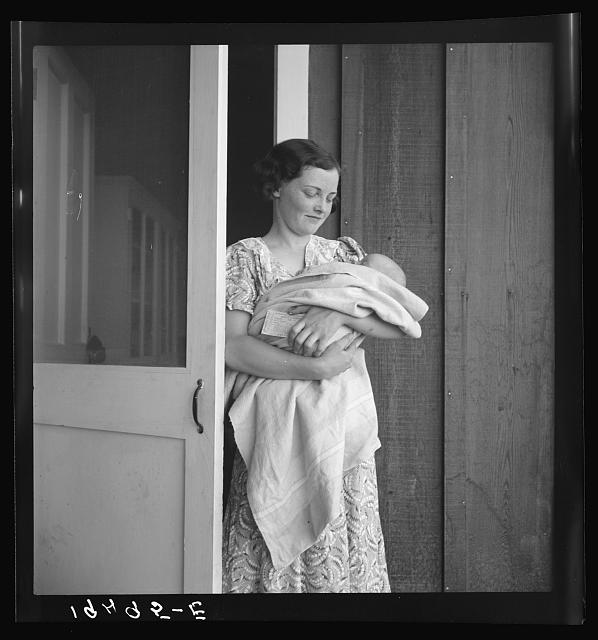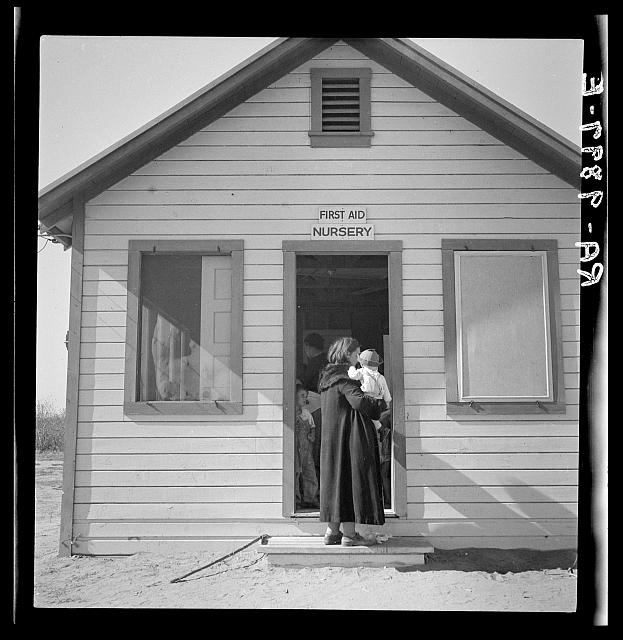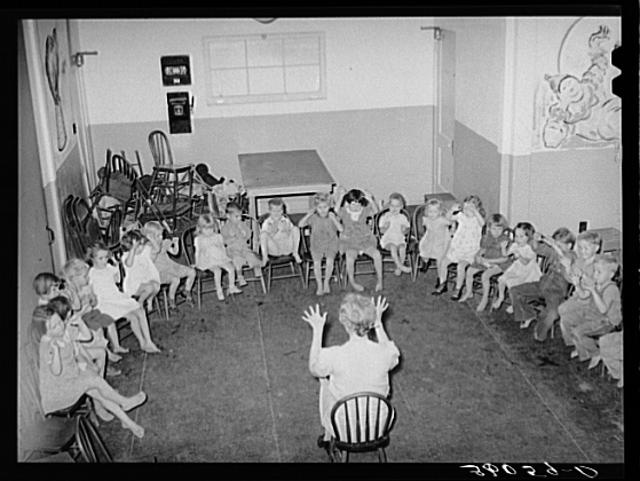Home | Introduction | Literature Review | Data and Analysis | Conclusion |References
Power and Control
Brian Cannon, in his 1996 essay “‘Keep on A-Goin’: Life and Social Interaction in a New Deal Farm Labor Camp,” begins his writing with optimism about the benefits of the camps as a whole, especially noting health care aspects such as the free nurse and first aid station (Cannon, 1996, p. 9). Further in the essay, however, he seems unimpressed with other aspects of the program, particularly in matters concerning perceptions of government control. Cannon believes the Resettlement Administration had low success at the beginning of the program due to farmworkers’ perceptions of power and control by the government. Many family figureheads ultimately refused offers to live at the migratory labor camps, due to concerns of overarching government power and regulation on themselves and their families (Cannon, p. 5). Historian Veronica Martínez–Matsuda agrees that control from the government was prevalent in the camps, and believes that the scopes of government power and control extended beyond that of the standard labor and economic concerns. Although sometimes benefiting from the many services camps provided, Martínez-Matsuda believes many Mexican migrant families and their children were compromised from their personal beliefs, autonomy, and customs (Martínez-Matsuda 2009, p. 220) through rehabilitation attempts regarding physical and financial health. Instituted by the FSA to aid migrant families, Martínez-Matsuda believes these rehabilitation attempts were just one way in which the administration exerted power over the bodies and lifestyles of migrants, as there became reason to pathologize Mexican customs, ultimately enforcing westernized beliefs surrounding medicine and the home. Further, she believes the extensive measures taken in the medical care program, such as frequent preventative education, was also an attempt to settle the general societal belief that migrants and their children were “dirty” and diseased, allowing for a publicized method of control over such ‘undesirable’ migrant qualities and ultimately proper assimilation of migrants into American society (2009, p. 207). Michael Grey, in his analysis of the FSA’s rural health programs book New Deal Medicine, considers “[t]he incorporation of preventive health practices, particularly those relating to maternal and child health” as “one of the defining characteristics of the New Deal’s rural health effort” (Grey, 1999, p. 44). He further states children’s health care “occupied an important position in the priorities of the FSA’s experiment in rural health care,” and Grey’s interviewees found the practices were successful, especially in prenatal care and deliveries (p. 86). These programs had many benefits to the health of migrant mothers and children, such as limiting infant mortality rates within the camp and allowing previously underserved populations to access healthcare. These programs, however, also aided in expanding the state’s influence on previously unregulated communities, whether for perceived public benefit or detriment.
Cannon’s optimism on the healthcare system in the Farm Workers’ Communities weakens in tandem with Martínez-Matsuda, as he notes that benefits of the medical program were commonly overshadowed by trends of refusing camp medical care among families, whether for religious or cultural reasons (Cannon, 1996, p. 23). Although the initial description of the FSA from both authors focus on its success, their analyses then moves towards the shortcomings within the program, both within the general power structures of the camps and the systemic lack of recognition for the diversity embedded in migratory life, affecting the lives of the children involved.

Mother comes to the Farm Security Administration camp with sick baby and FSA agricultural workers medical association card. Lange, D., photographer. (1939).

Nursery and First Aid station at Kern Migrant Camp. Lange, D., photographer. (1936).
Race and Class
Further in his article, Cannon mentions that camp administrators hoped that as a result of community interaction, migrants would recognize their power to improve their own lives through collective action and ultimately improve their own socio-economic conditions (p. 19), and in their attempt to encourage communal action, held elections for positions on camp council and other committees. However, Cannon believes the councils and committees, in tandem with high rates of turnover and uncomfortable, spatially proximate living conditions within the camp, fostered feelings of consciousness among residents rather than fostering a sense community (p. 22). These feelings of consciousness enforced that same sense of control and supervision not just from administration, from within the community itself. Still, many scholars highlight community as one of the positives that came out of the Farm Workers’ Communities. In interviews with past residents, Robbins and Robbins note that despite racial segregation and uncomfortable living situations, farmers and farm children of different races were able to come together in a shared community for shared resources, “sings”, dances, and play (Robbins & Robbins, 2015 p. 256). Robbins, Robbins, and Martínez-Matsuda (Martínez-Matsuda, 2009, p. 12) agree that the FSA aimed to teach migrant families the virtues of cooperation, good health, and education, but specifically in the racialized and gendered structures of American culture.
Not only segregated by race, Farm Workers’ Communities were segregated by class in the form of available housing (Cannon, p. 30). While some families lived in adobe houses with small gardens, the rest of the families were resigned to tents. Cannon believes that this only further segregated families in the migratory camps, precluding their abilities to come together as a community. A growing influx of Mexican migratory workers may have only further precluded this sense of community and increased segregation, as Martínez-Matsuda believes white migratory families and local landowners feared Mexican workers would compete with them for work (2020, p. 222). However, Martínez-Matsuda further recounts instances of children being ‘left behind’ at the camps while their parents migrated for work elsewhere. Moving to other Farm Workers’ Communities throughout harvest seasons would require removing children from school, and many farm families had created a trustworthy community environment in which they could leave their children behind. (2020, p. 115). Despite the embedded structure of the space encouraging political ideals regarding class structure and race, the spatial realities of the Farm Workers’ Communities in times of destitution allowed for many instances of cooperation on the individual level between sexes, races, and ages.
In her doctoral dissertation, Martínez-Matsuda also focuses explicitly on Mexican migrant workers in Texas, discovering inequities towards Mexican children at local schools. Although the Farm Workers’ Communities intended for easy access to schools in the area in the creation of the sites, Martínez-Matsuda shows that it was the local attitudes towards migrants and Mexicans as a population that was cause for limited access to education. Stigmas surrounding migrant laborers made it hard for Mexican children to attend school without discrimination, and many were subsequently barred from school by the state due to local racism (Martínez-Matsuda, 2009, p. 283). For many families, school was not an option in light of labor expectations in the camps. Many children worked on the farm as well instead of attending school (2009, p. 79). Further, Martínez-Matsuda argues that since the communities themselves were intended to be temporary, many children who had finally been able to access a good education were removed from it only shortly afterwards (Martínez-Matsuda, 2020, p. 115). Ultimately, the structure of the communities and therefore instability of access to education linked family economic status directly to lower educational advancement, the opposite of what the administration had intended to do. Martínez-Matsuda’s graduate research relates to Sidney Baldwin’s work, Poverty and Politics: The Rise and Decline of The Farm Security, which analyzed the structure and ultimate decline of the program. Although the social needs of the destitute farm population were recognized, and solutions formulated by the FSA allowed many of these needs to be met, Baldwin believes the political environment of America during the Roosevelt administration perpetuated much of the opposition to the program and created many adverse effects on those who they were intended to help. To Baldwin, the Resettlement Administration and subsequent takeover by the Farm Security Administration was not an abject failure, but rather a series of bold and calculated risks made in a time of American social and political unrest (Baldwin, 1968, p. 419). Local taxpayers did not want to pay for migrant children to attend their schools, nor did they want the economic competition of the influx of laborers in farm workers’ communities. Despite the efforts of the FSA in ensuring a local education for farm children, local discrimination, and strict attitudes towards migratory working families – both societally and in the workplace – ultimately undermined the effectiveness of FSA policies and enforced societal ideals regarding class and race.
Constructions of an Ideal, American Childhood

Lee, R., photographer. (1940). Children of migratory agricultural workers playing games, at the WPA Work Projects Administration nursery school at the Agua Fria migratory labor camp. Arizona.
Through the scholarly analyses by Martínez-Matsuda and Cannon, the spatial realities concerning power, control, race, and class, are shown to have greatly affected children, as well as promoting the perceived notion of an American ‘ideal childhood.’ While many parents worked in the fields, children attended nursery schools. These schools, alongside childcare, taught children values such as a nutritious diet, preventative measures to keep children from getting sick, and concepts of the nuclear family. Martínez-Matsuda believes this curriculum, although beneficial to the health of migrant workers and their children, constructs an image of an ideal childhood where children have two parents, a stable home, and a nutritious diet—a childhood that was not reality for most migrant children. These outlines within the education system create an ideal image of childhood for migrant children to aim for, perhaps both in their infancy and as parents themselves. Further into the public education system, constructions of the ideal American childhood were portrayed in the sheer urgency to educate and ‘reform’ migrant children. In educating these children, Martínez-Matsuda believes it was intended as an attempt to solve the grander, national issue of destitution among farmers, and further, solve the local negative perception of migrant children as uneducated, unhealthy, and thus unwanted.
As noted by Martínez-Matsuda, however, it was much harder for latin-american families to access education for their children. She believes this was due to the higher expectations on the families in labor settings, likely due to racial assumptions, as well as racial discrimination at school. Thus, many Mexican children worked in the fields instead of attending school during the day. Martínez-Matsuda argues that Mexican children, although intended by the FSA to receive benefits, were not allotted the same construction of an ‘ideal childhood’ that the white children were to receive. Further, she believes that education and ideals within the camp space were only some of the many factors that infringed on the access of latin-american children to the ‘ideal’ childhood granted to their white peers. Although built near town-centers to accommodate families and their needs, many Mexican children in the camps were unable to utilize town amenities and play-spaces due to segregation, nor did most have the money for them (Martínez-Matsuda, 2009, p. 183). Thus, many Mexican children could not play or learn as easily as the other children. Scholarly analysis reveals the many intricate factors of federal labor camps, including external factors such as race, class, and gender, and how they intertwine with constructions of the ideal American childhood.